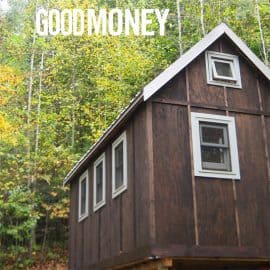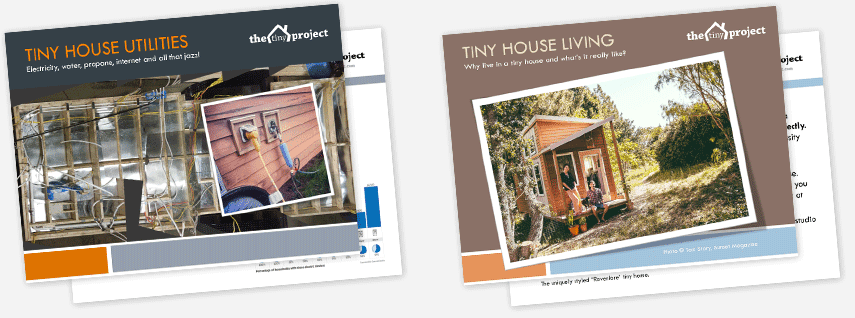The true (and unmentioned) cost savings of living small
 My friend and fellow tiny houser, Laura LaVoie of Life in 120 Square Feet, recently wrote a good post expanding on an article that may mislead some about the true cost of tiny houses and small living. Here's what happened:
My friend and fellow tiny houser, Laura LaVoie of Life in 120 Square Feet, recently wrote a good post expanding on an article that may mislead some about the true cost of tiny houses and small living. Here's what happened:
Laura and I (plus some other tiny house greats, like Lina Menard and Christopher Carson Smith) were contacted by the Lauren Modery (writing for GOOD magazine) for research into tiny house (and tiny living) costs. She asked some great questions about how much our houses cost and what our cost of living was like now that we've been living tiny for quite some time.
The problem is that the final article she published mentioned hardly any of the many cost saving benefits (or other benefits, challenges & lessons learned) of living small, and focused almost entirely on the initial cost of building (slanted towards showing tiny houses as less cost effective than they really are). This was not a bad article, and I'm sure many will find it very informative, but in many ways it misses the point. Even with respect to cost, she failed to mention how if living in an expensive city (like Austin) the amount saved on rent and utilities alone can theoretically pay for he cost of the house in as little as 3-5 years depending on how things work out.
To give readers a full picture of the true costs (and cost savings), here are my complete answers to her interview questions, most of which did not make it into the article.
1) I see that you built your home yourself? Good for you! What was that experience like, specifically pertaining to finances? Was it cheaper for you to build by yourself vs. a contractor?
Yes, of course it was much cheaper! I built it myself knowing that I could afford the cost of materials, but was not about to pay something tens of thousands of dollars in labor to build it for me. Plus, being of my own design, I really wanted to do most of it myself to make sure it was built exactly as I wanted and so I could choose all the materials, building techniques and appliances myself. I had already saved the money I had estimated I'd need for materials ($25k -- it turned out to be about $30k) so knew I could afford to build it as long as I could do most of the labor myself.
2) Did any surprise costs come up while you were building? Land? Permitting? Utilities? Materials?
I'd say Time and Commitment were the main ones. As I'm sure everyone who builds themselves would say after the fact, it took more time than I had anticipated, and was also challenging physically and emotionally. I was working nearly full-time while building, taking every evening and full weekends to build. It was an exhausting routine, but I felt that's what I needed to do at the time. It all worked out beautifully, but if I had more time it would have been less stressful. The emotional aspect was really just being able to juggle many things at once, work and personal life along with keeping literally hundreds of little details of the build in my head at all times. It is a big commitment to take on a project like this (even with it's relatively small size), so you need to know what you are getting into.
Sourcing materials was actually a fun part of the challenge because it really allowed me to find what I loved to create a truly custom home that felt great to me. I did a lot of planning ahead of time to make sure ordering items like windows would not hold up the build. Building at a small scale also came in handy to get deals on left over items and smaller quantities that stores can't usually sell to use in homes of standard sizes.
Finding a parking spot was something that I only needed to deal with once the house was done, and for me was not all that hard. I was able to find a place to stay for a couple years when I lived in Norther California and again when I moved to Austin. This can be a big hurdle for some, but in my case, worked out well in both cases.
3) Has your tiny home been cost-effective for you?
Yes, very. Once complete, my cost of living was reduced dramatically. The amount I paid in rent to park somewhere was always a small fraction of what it would have been to rent an apartment in the same area, and with a small, very efficient house, my utility costs were incredibly low. Power has always been included in my rent so I can't say for sure about that (but it's all LED lights and efficient appliances), but I used propane for heating elements to reduce electricity demand and cost.
With lower cost of living, I found I was able to save every month and therefore essentially pay for the cost of building the house in just a few years living in it. So much better than a 20 year mortgage!
4) What would you tell someone building a tiny home? Any cautionary tales?
There a lot of potential pitfalls and cautionary tales. Most I've heard are people who've been scammed or unfairly treated by builders who are cutting corners or trying to make quick money by delivering very poorly built houses. This of course does not apply if you build your own. But for those looking to buy a completed house, do your research carefully. Make sure you find former customers (other than the builder might direct you to) and personally check with to make sure they are happy with the house they received. As with most industries there are people of all types, so just make sure you find one of the good ones! There are lots of amazing people out there but as the industry really started to blow up over the last few years with all the reality TV shows and all that, there are builders and tiny house companies popping up all over literally every day -- some of whom with shady business ethics and no real commitment to produce great work or advance the movement for the benefit of others.
Zoning and code issues are an important discussion as well. Where to park and the legalities of full-time living are possibly the biggest road block for most people wanting to live this lifestyle.
As part of the Tiny House Collaborative, I help teach workshops around the country where we address these issues and much more. Tiny House 101 (a 2-day comprehensive beginner workshop) and Community and Zoning (half-day) workshops are available. For more, please see https://www.thlab.org/workshops/
5) Do you think tiny homes are sustainable for long-term living?
Yes, but not for everyone, obviously. Personally, I think I could live in mine forever (or for a long time), as I love the small space highly customized to my needs. If well designed, the size of the space becomes less important. All apartments I've lived in were not well designed, always lacking storage, and did not make great use of space. My tiny house make great use of all available space so in many ways feels more open and functional than much larger spaces I've lived in. But even if not used for long-term living, their relatively low cost to build means even a shorter time in them can still be very cost effective.
And then a follow-up question:
6) Of the $30,000 you spent for your tiny house, what was the biggest cost? Would you be able to provide a very quick breakdown of costs for the 30k?
Here are some rough approximations:
Trailer: $3.5k
Windows and door: $5.5k
Metal roofing and cedar siding: $4k
Appliances + fixtures: $3.5k
Tools: $1k
The rest is just lumber, hardware, and all the other general construction stuff.



I would suggest volunteering to help build a tiny house. Construction is a science and you can learn so much by doing. One person building always needs someone to hold the other end of something, or go run get something. My dad was a carpenter. Some people do stuff i would never think of doing that way. Accidents and errors can kill. M